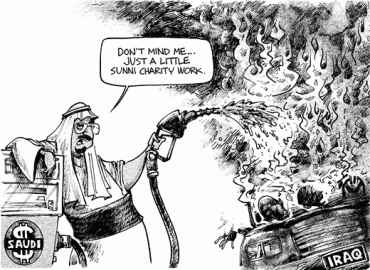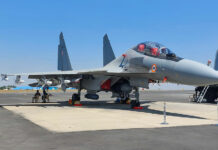 Is the House of Saud a ‘more established and diplomatic version of ISIS’?. After all, the extremist Sunni terror organization shares the Saudi extremist Wahhabi theo-fascism, lack of human rights and intolerance. In fact, ISIS external sources of funding are believed to be Iraq’s neighbors – Qatar, Saudi Arabia and Kuwait.
Is the House of Saud a ‘more established and diplomatic version of ISIS’?. After all, the extremist Sunni terror organization shares the Saudi extremist Wahhabi theo-fascism, lack of human rights and intolerance. In fact, ISIS external sources of funding are believed to be Iraq’s neighbors – Qatar, Saudi Arabia and Kuwait.
Officially Riyadh views the Islamic extremism as a terrorist organization that poses a direct threat to the kingdom’s security. The Interior Ministry formally designated ISIS as a terrorist entity in March, along with Jabhat al-Nusra, the Muslim Brotherhood, Yemen’s Houthi rebels, and Saudi Hezbollah.
However, informally, the Saudi regime is paying the Islamic extremist factions huge sums of money to save its own involvement in the conflict, a traditional attitude, the House of Saud has maintained, whenever a dangerous situation has developed. Keeping a vast arsenal of ultra-modern weapons on storage the Saudi military has sofar refrained from using it, except in small conflicts like Yemen.
For ISIS this is a win-win situation. Not only does it gain publicity while carrying out its terror strikes, but with the money that it earns, it also laughs its way into the bank. Moreover, Saudi involvement has already become much deeper and more long-term than just increased funding, with more Saudi fighters coming to Syria than from any other country. To such movements, the Riyadh rulers are shutting their eyes or just ignore it.
The beliefs of Wahhabism, the puritanical literalist Saudi version of Islam recognized exclusively by the Saudi educational system, are not much different from those preached by al-Qaeda and ISIS. Wahabism wholly rejects all other types of Islam beliefs and regards Shi’ism as a heresy in much the same way Catholics in Reformation Europe detested and sought to eliminate Lutheran Protestantism. All this is not new, but is getting more dangerous as the Islamic Sunni-Shia conflict spreads.
How far is Saudi Arabia complicity in the ISIS takeover of much of northern Iraq, and is it already stoking an escalating Sunni-Shia conflict across the Islamic world? Some time before 9/11, Prince Bandar bin Sultan, once the powerful Saudi ambassador in Washington and head of Saudi intelligence until a few months ago, had a revealing and ominous conversation with the head of the British Secret Intelligence Service, MI6, Sir Richard Dearlove. Prince Bandar told him: “The time is not far off in the Middle East, Richard, when it will be literally ‘God help the Shia’. More than a billion Sunnis have simply had enough of them.”
The fatal moment predicted by Prince Bandar may now have come for many Shia, with Saudi Arabia playing an important role in bringing it about by supporting the anti-Shia jihad in Iraq and Syria. The chilling forecast by Prince Bandar, who was at the heart of Saudi security policy for more than three decades, that the 100 million Shia in the Middle East face disaster at the hands of the Sunni majority, will convince many Shia that they are the victims of a Saudi-led campaign to crush them.
The origins of Saudi Arabia’s anti-Shia stance can be traced back to the alliance between the Wahhabism and the House of Saud dating from the eighteenth century. If ISIS were ever to become an established state, after a few decades, one can imagine it might resemble Wahabist Saudi Arabia.
How does Saudi Arabia go about spreading such extremism and still remain a US ally? The extremist agenda is not always clearly government-sanctioned, but in monarchies where the government money is spread around to various princes, there is little accountability for what the royal family does with their government funds. Much of the ISIS funding is via charitable organizations and is not directly military-related.
Actually, the royal House of Saud works against the best interests of the West and even the Muslim world. Muslim communities worldwide certainly need to eradicate fanatical Wahhabism from their midst, but this will become difficult, if not impossible, to accomplish if the West continues its support of the House of Saud. The monarchy must be modernized and modified or simply uprooted and replaced. The House of Saud needs a thorough house cleaning.
Based on its own intelligence, it seems quite ridiculous that the West is constantly strengthening ties with the very people who have spent an estimated $100 billion spreading the foundational Islamist creed of ISIS, which is considered its fiercest enemy since WW2!
As the present US attitude may seem already strange in this complicated situation, a new, old factor is entering the scene: Saudi Arabia on recently signed six military and economic agreements with Russia, Al Arabiya News Channel reported. The news comes after Saudi Deputy Crown Prince Mohammed bin Salman bin Abdulaziz met with Russian President Vladimir Putin at the Konstantin Palace in St. Petersburg after arriving in Moscow on an official visit, the state-run Saudi Press Agency (SPA) reported.
For Russia, the Middle East has historically been a region of strategic and economic importance. Russia is seen as an alternative to the Western ideological framework, granting it a special status in the area. Apart from being a consistent alternate power, Russia’s objectives and policies in the Middle East have always changed depending on its relationship with the Western powers.
While in Riyadh, those on the upper echelons of power seem to remain loyal to the U.S.-Saudi alliance, the recent secretive deals between high-ranking Russian and Saudi officials seem out of place. However President Obama’s “Hands-Off” policy in the new Middle East created a perfect situation for a tête-à-tête parley between Vladimir Putin and the Deputy Crown Prince, a less pro-Washington figure in the Saudi leadership, who met in St. Petersburg in June 2015, indicating King Salman’s change of policy with Russia.
There are unconfirmed talks of Russian investing in the construction of nuclear power plants, increasing arms sales and negotiating oil prices. This is understandable, considering the fact that the current Saudi leadership is disillusioned with Obama’s policy in the Middle East, especially regarding Iran, and thus aims at cementing bilateral ties with the Russian leadership. Russia, on its side is investing in both sides, establishing closer relations with political and military leadership in Tehran.
The Saudi objective is to dissuade Putin from his unwavering support of Assad, whereas Putin’s is to reduce Saudi’s overwhelming influential oil production, in order to spike global oil prices. This is understandable, considering the fact that the current Saudi leadership is disillusioned with Obama’s policy in the Middle East, especially regarding Iran, and thus aims at cementing bilateral ties with the Russian leadership.
Whatever happens in Iraq and Yemen, the political temperature of the region is getting hotter by the day. Looked at from a Saudi and Gulf monarchy point of view, Iran and the Shia are on the advance, becoming either the dominant or the most powerful influence in four Arab capitals: Baghdad, Damascus, Beirut and Sanaa. The Sunni Arabs in Iraq and Syria have linked their futures inextricably and fatally to ISIS and other al-Qaeda type organisations. Should it maintain its present attitude the dramatic developments in the turbulent Middle East conflict, the West may have to pay a heavy price for its traditional alliance with Saudi Arabia and the Gulf monarchies, which have always found Sunni jihadism more attractive than democracy.












